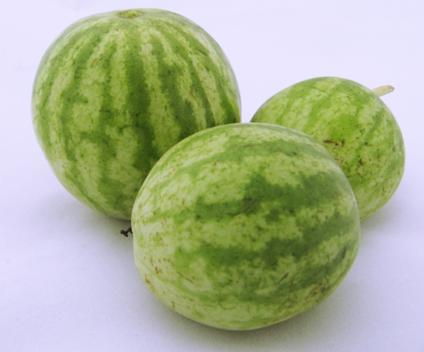Skip over navigation




Or search by topic
Number and algebra
Geometry and measure
Probability and statistics
Working mathematically
Advanced mathematics
For younger learners
Watermelons
Age 7 to 11
Challenge Level 





- Problem
- Getting Started
- Teachers' Resources
Watermelons

Here are three watermelons.
The one in the front of the picture weights 7.35kg.
The one on the left of the picture weights 8.20kg.
The one on the right of the picture weighs 6.45kg.
In a melon-growing competition, a melon is awarded a point for each gram that it weighs.
How many points does each melon gain?
Can you explain how you worked this out?
How many points does each melon gain?
Can you explain how you worked this out?
Why do this problem?
This problem gives children opportunities to become more familiar with the units of mass. It requires learners to convert between units (g and kg in this case) and offers a context for a range of calculations.Possible approach
It would be good to introduce this activity using something to represent the melons, for example balls of different sizes and weights. Ideally, real watermelons would be wonderful so that learners can handle them and get a 'feel' for their masses. Of course the problem could be adapted to focus on any seasonal and readily-available fruit or vegetable.
Once you have presented the task, give children time to explore in pairs or small groups without saying much more. Depending on learners' experience, you may need to bring the whole group together for a short time (a mini plenary) to discuss the meaning of the units, kilograms and grams.
You could invite children to create a poster which describes how they approached the task. The plenary could then involve giving time to walk around the room, looking at everyone's posters.
Once you have presented the task, give children time to explore in pairs or small groups without saying much more. Depending on learners' experience, you may need to bring the whole group together for a short time (a mini plenary) to discuss the meaning of the units, kilograms and grams.
You could invite children to create a poster which describes how they approached the task. The plenary could then involve giving time to walk around the room, looking at everyone's posters.
Key questions
How can you find out how much each melon weighs in grams?
How did you work this out?
How did you work this out?
Possible extension
Children could be challenged to come up with other mathematical ways that the melon-growing competition could be judged.Possible support
It would help to have some scales available, if possible, particularly if both grams and kilograms are marked.You may also like
What's My Weight?
There are four equal weights on one side of the scale and an apple on the other side. What can you say that is true about the apple and the weights from the picture?
Pies
Grandma found her pie balanced on the scale with two weights and a quarter of a pie. So how heavy was each pie?
Oranges and Lemons
On the table there is a pile of oranges and lemons that weighs exactly one kilogram. Using the information, can you work out how many lemons there are?

